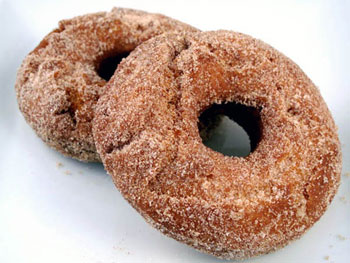 Doughnuts were a Sunday tradition in my house. Everyone sitting around the kitchen table, sipping coffee, reading various sections of the paper, (I usually opted for Parade Magazine) and reaching for a doughnut.
Sometimes my sister would arrive with a variety box of Dunkin Donuts,
other times it would be store bought Freihofer’s mixed dozen – plain,
powdered, and cinnamon sugar (my favorite).
Doughnuts were a Sunday tradition in my house. Everyone sitting around the kitchen table, sipping coffee, reading various sections of the paper, (I usually opted for Parade Magazine) and reaching for a doughnut.
Sometimes my sister would arrive with a variety box of Dunkin Donuts,
other times it would be store bought Freihofer’s mixed dozen – plain,
powdered, and cinnamon sugar (my favorite).
This recipe from ‘The Yellow Farmhouse Cookbook’ delivers a near perfect old fashioned country doughnut – crunchy on the outside, moist nutmeg spiced cake on the inside. I rolled mine in cinnamon sugar, but they’re great plain, with powdered sugar, or even a chocolate glaze. Make them when you’ve got plenty of friends and family around to enjoy them while they’re warm – they do not store well.
A note from the cookbook: One of the secrets to the best buttermilk doughnut recipe was the right frying medium. Vegetable shortening in the form of Crisco produced a much less greasy doughnut than vegetable oil or peanut oil. Temperature is important, too – at 350°F, the dough absorbed too much oil; at 385°F the outside started to burn before the inside could cook through. Best results are achieved by bringing the oil up to 375°F before adding the doughnuts; it falls back to 360-365 degrees once the doughnuts are dropped in.
Homemade Cinnamon Sugared Buttermilk Doughnuts
3 ½ cups unbleached all-purpose flour, plus extra for surfaces
1 cup granulated sugar
1/2 teaspoon baking soda
2 teaspoons baking powder
1 teaspoon table salt
1 ½ teaspoons fresh grated nutmeg
3/4 cup buttermilk
4 tablespoons unsalted butter, melted
2 large eggs
1 egg yolk
6 cups vegetable shortening for frying
Topping:
1 cup granulated sugar
1 ½ tablespoons ground cinnamon
1. Mix 1 cup flour, sugar, baking soda, baking powder, salt, and nutmeg in bowl of standing mixer fitted with paddle attachment.
2. Mix buttermilk, butter, and eggs in 2-cup Pyrex measuring cup. Add wet ingredients to the dry; beat on medium speed (number 4 setting on a KitchenAid) until smooth, about 30 seconds. Decrease speed to low (number 2 setting on a KitchenAid); add remaining flour and mix until just combined, about 30 seconds. Stir batter once or twice with wooden spoon or rubber spatula to ensure that all liquid is incorporated. (The dough will be moist and tacky, a cross between cake batter and cookie dough.)
3. Fit candy thermometer to side of cast-iron kettle or large, heavy-bottomed soup kettle; gradually heat shortening over medium-high heat to 375 degrees (or use a deep fryer if you have one). Meanwhile, turn dough onto floured work surface. Roll with heavily floured rolling pin to 1/2-inch thick. Stamp out dough rings with heavily floured doughnut cutter, reflouring between cuts. Transfer dough rounds to jelly roll pan or large wire rack. Gather scraps and gently press into disk; repeat rolling and stamping process until all dough is used. (Cut doughnuts can be covered with plastic wrap and stored at room temperature up to 2 hours.)
4. Carefully drop dough rings into hot fat four or five at a time, depending on kettle size. Turn doughnuts as they rise to surface with tongs, a Chinese skimmer, or a slotted spoon. Fry doughnuts until golden brown, about 50 seconds per side. Drain on paper towel-lined jelly roll pan or wire rack. Repeat frying, returning fat to temperature between each batch.
5. Mix sugar with cinnamon in small bowl. Cool doughnuts about 1 minute and toss with cinnamon sugar to coat.
Makes about 15 doughnuts
James Moore has been a cooking enthusiast since childhood and started blogging as a way to share favorite recipes with friends and family. His site, Cook Like James has grown to include restaurants, cookbooks, wines, and favorite places.

